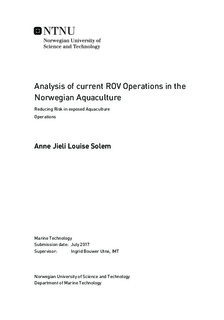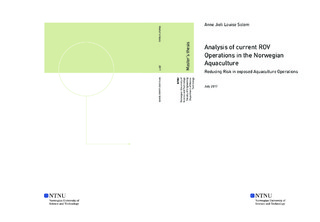| dc.description.abstract | The Norwegian aquaculture is already considered to be one of the most dangerous occupations when it comes to risk, and the risk is likely to be amplified as the industry wants to expand and utilize more exposed areas. These areas are characterized by more extreme and unpredictable weather conditions, including higher wave heights and stronger currents, which challenges the safety and efficiency of current operations. Several inspection, maintenance and repair (IMR) operations today are highly dependent on manual labour, which leads to close human interactions that put the workers at risk.
This master thesis addresses how increased use of ROV operations can help reducing the risk in exposed aquaculture operations. The main objective is to provide knowledge about the current situation for ROV and diving operations in the Norwegian aquaculture. The purpose is to gather information from the industry itself, focusing on why and how increased use of ROVs will help mitigate the risk, by assessing strengths, weaknesses, challenges and costs compared with divers. Information has been gathered through observations, interviews and conversations with different stakeholders, resulting in a very comprehensive result part covering several topics within the area of interest. The results where then assessed in light of the purpose.
The thesis confirms that some of the most detailed diving operations need to be solved by divers, and that ROV will probably never be a 100% able to replace them. Furthermore, the thesis confirms that the harsh environment form the greatest challenges.
An overall conclusion is that increased use of ROVs will create a positive chain reaction against reduced risk and increased efficiency. It will mitigate the human risk by taking over several diving operations. Operational efficiencies are also believed to increase, as a ROV is able to move faster than a diver in the water. Although researchers and manufactures are working hard to find new and better solutions, the thesis confirms that there are still a lot of challenges related to the use of ROVs for various IMR operations that needs to be solved to mitigate the increased risk in these areas. | |

